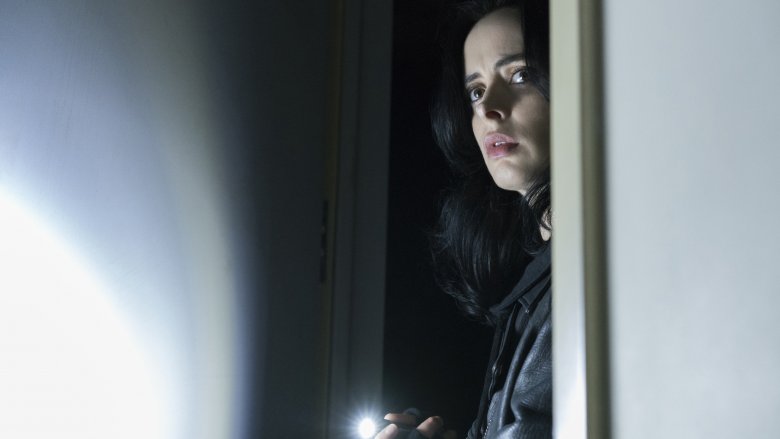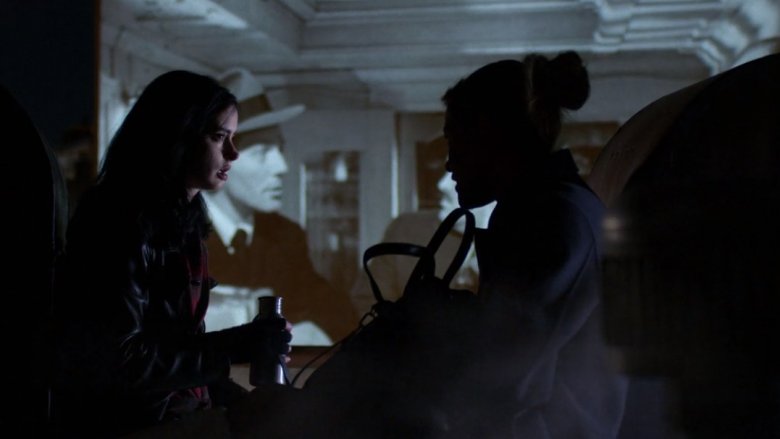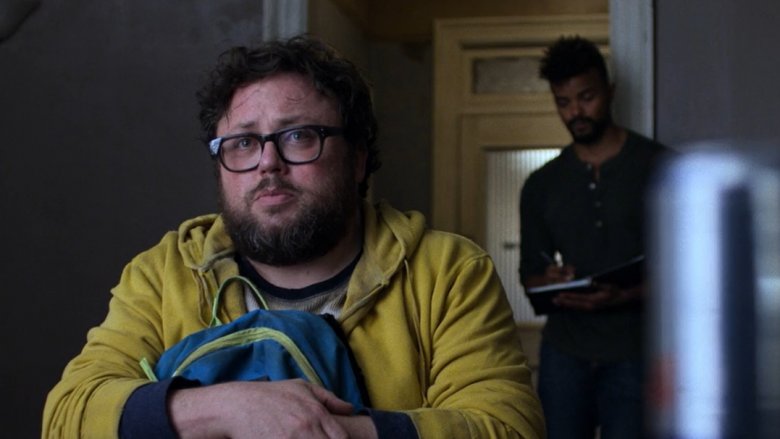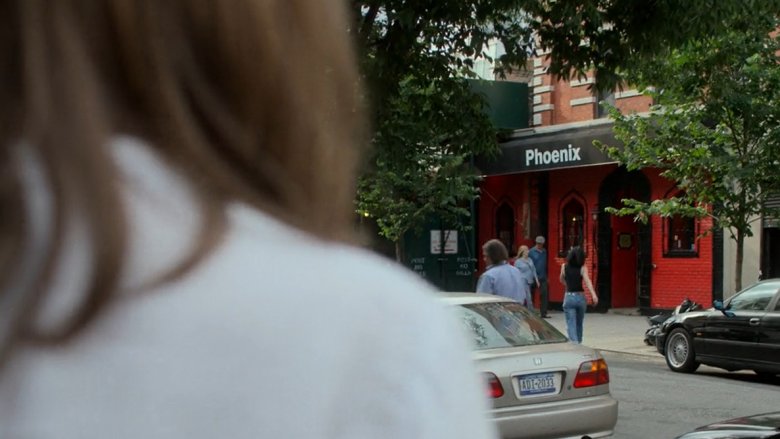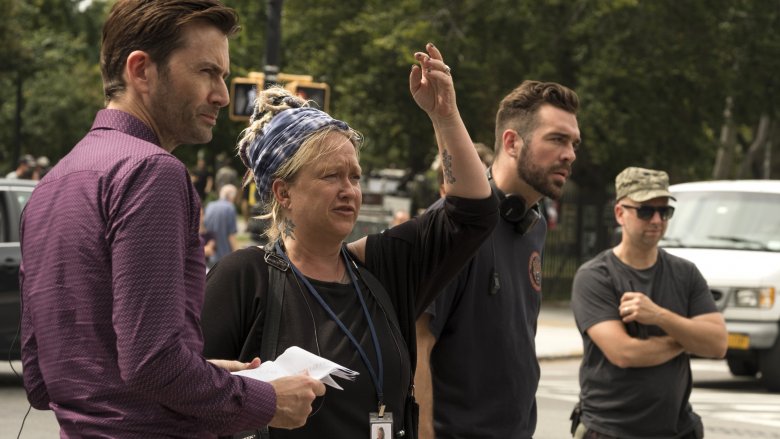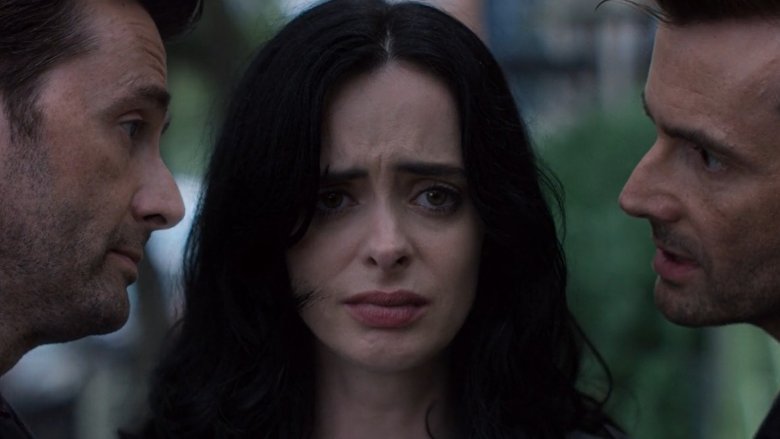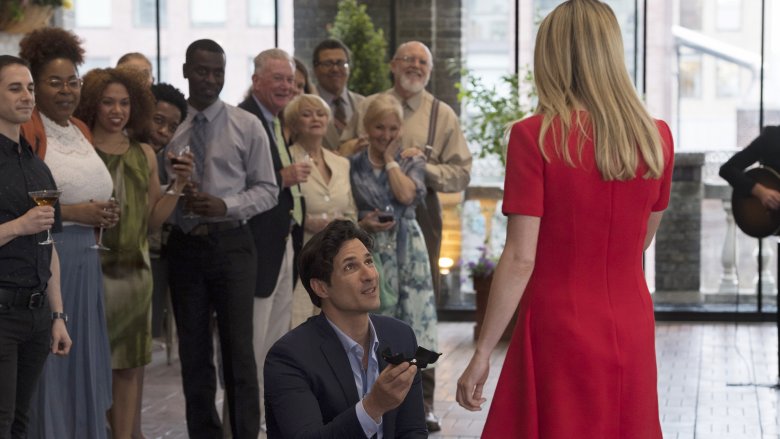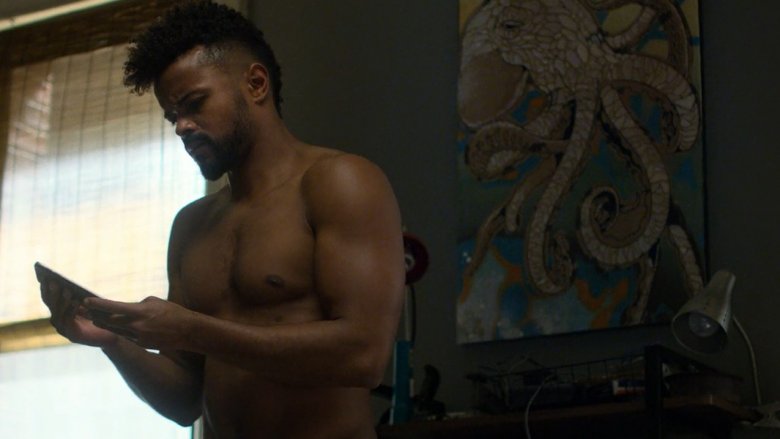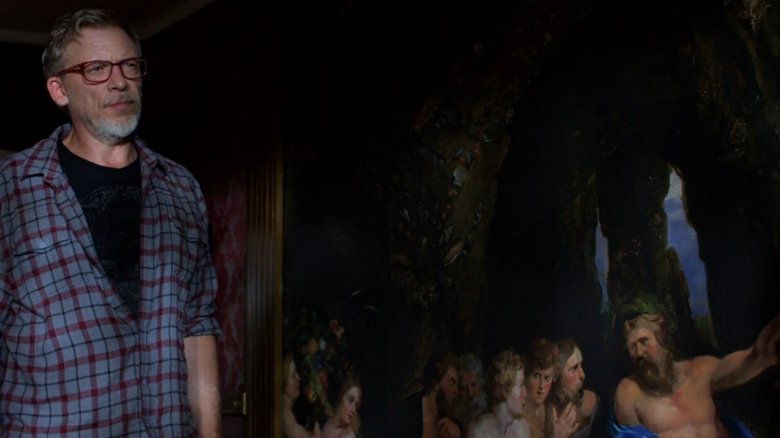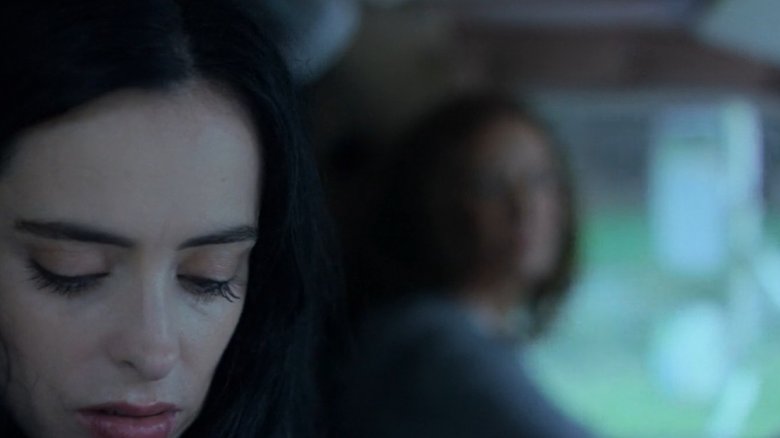Small Details You Missed In Jessica Jones Season 2
WARNING: This article contains many spoilers for Marvel's Jessica Jones season 2!
Comic book adaptations have become synonymous with so-called "Easter eggs." Even before Marvel Studios established its dominance in superhero films, Bryan Singer littered the first two X-Men films with nods to the comics universe that only the fans would recognize.
The second season of Marvel's Jessica Jones has plenty of Easter eggs — Marvel monster stickers on a teenager's tablet, Bronze Age supervillains mentioned on radio talk shows in passing — but there's a lot more to the show than obscure comic book references. The new season of Jessica Jones references classic films, Greco-Roman myth, and, yes, comic books — but not just to provide fans the opportunity to impress their less invested friends, to echo the themes of the stories.
Art in particular plays an important role in season 2 of Jessica Jones. Often if you want to know who a character is, you don't need to look further than their walls. Here are the small details you missed in Jessica Jones season 2.
The Killers
The first time we see Jessica Jones and Trish Walker together in the second season, they're on a rooftop where some anonymous local screens black-and-white films either on a wall or the back of a billboard. In the later flashback episode "AKA I Want Your Cray Cray," we learn this is an old ritual for the sisters.
The film they're watching is the classic 1946 film The Killers, about a pair of hit men (played by William Conrad and Sean McGraw) hired for an assassination in a small New Jersey town, and the backdrop is more than film buff fodder. While the word "killer" already describes Jessica Jones, by the end of the season, the title of the film will accurately describe both sisters.
It's worth nothing The Killers was adapted from a short story of the same name written by Ernest Hemingway, who isn't considered to have been the most enlightened author by many feminist scholars. That small detail could have nothing to do with why it's used here, but considering Jessica's ever-present fear that she will turn — or already has turned — into precisely the kind of monster she hates, that seems unlikely.
The Whizzer's trophies
When Jessica searches the apartment of Robert Coleman, a.k.a. The Whizzer, it's a little bit like Morgan Freeman and Brad Pitt discovering John Doe's home in Seven. Coleman's home is a testament to obsession. There's hardly room for anything but the metal hardware shelves of books and notebooks — along with the extensive tube system Coleman built for his pet mongoose.
It's easy to miss them, but Coleman also has a bunch of track trophies. Which, duh, right? He has super speed, why wouldn't he have track trophies?
In one of his videos to Trish, Coleman says he didn't get his powers until he was 18 and that he was fast before he got them. He also tells Jones the speed only works when he's scared, and that he was called "The Whizzer" before IGH gave him powers. Considering all this, it's likely he won the trophies long before he had his accident or heard of IGH.
Imagine the horrible irony of being possibly the fastest man alive, being in fear for your life because of the baggage that came along with the super speed, being obsessed with hiding from the people who gave you the powers and exposing them — all while some of your only happy keepsakes are the trophies you won for being faster than everybody else all on your own.
Two Phoenixes
There are a lot of references to Greco-Roman myth in season 2 of Jessica Jones, a lot of comic book references, and a lot of the most brilliant small details manage to be a mixture of both.
One example is the Phoenix bar, where Jessica's mother Alisa follows her in Episode 7, "AKA I Want Your Cray Cray." It's where Alisa, overhearing his plan to pimp Jessica out as muscle, murders Jessica's boyfriend Stirling.
The Phoenix of Greek myth would live for many years, die, and be reborn — in some versions of the stories, the phoenix would be reborn from its own ashes. It's a metaphor easily applied to both Alisa and Jessica.
But the Phoenix most comic book fans would think of upon hearing the name — the godlike creature Jean Grey eventually becomes in X-Men comics and films — is present here too. In a show about powerful women surviving horrific abuse at the hands of men, alluding to the hero who may not only be the most powerful female hero in Marvel Comics, but the most powerful Marvel character period, has to cast a shadow over the tone of the show, particularly when you consider the dark turn Phoenix takes on the page and the screen, and the darkness Jessica flirts with and Alisa outright marries.
The Directors
With the "Skip Intro" option available on Netflix, it's possible you may have missed the fact that while the music and the graphics are largely the same, there's one small difference between the opening credits in Jessica Jones season 2 and the first season. In the second season, the director credit comes after the opening theme and the graphics have finished — and more importantly, each of the 13 directors hired for season 2 are women.
Many of the directors are anything but new to comic book adaptations. Deborah Chow (Episode 4, "God help the Hobo") has worked on Fear the Walking Dead and Iron Fist. Rosemary Rodriguez (Episode 9 "AKA Shark in the Bathrub, Monster in the Bed") worked on Walking Dead and The Tick. Millicent Shelton (Episode 5 "AKA The Octopus) directed episodes of Runaways, Supergirl, and The Flash. Mairzee Almas (Episode 3 "AKA Sole Surivor") was First Assistant Director on 62 episodes of Smallville.
Fire walk with me
Jennifer Lynch, daughter of director David Lynch, directs Episode 11, "AKA Three Lives and Counting," which sees the return of David Tennant — not so much as the villain Kilgrave, but as an echo of the villain only Jessica can see. Throughout the episode, he harasses her with temptation to lash out at everyone with violence and become the murderer she fears she already is.
The choice of Jennifer Lynch for this episode in particular has a wonderful dark poetry to it. Her father is known for directing, among other things, Twin Peaks, in which a malevolent spirit possesses a man and forces him to rape and murder his own daughter. But here we have a woman who, in a way, is fighting against being possessed by the man who raped her — a man she killed. Unlike Leland Palmer of Twin Peaks, "AKA Three Lives and Counting" ends with Jones resisting the possession and remaining the flawed hero she is.
An indecent proposal
Jessica Jones writers had fun with Trish's love interest Griffin Sinclair. He's handsome, dashing, smart, and successful, so of course everyone started off assuming the guy was going to be a villain. And soon hints drop loudly that this is exactly who he is. We see him sneaking behind Trish's back, mentioning her in hushed phone calls, and going on her computer without her permission. Viewers suspect, at the very least, that he's going to try to steal Trish's stories. Then in Episode 5, "AKA The Sandwich Saved Me," everyone feels a little silly when it turns out the whole thing was a setup for a marriage proposal.
When you stop and think about it a little bit, though, you might realize you shouldn't have felt quite so silly about thinking Griffin is a bad guy: The proposal, as sweet as it may seem on the surface, is a subtle form of assault.
Everything about this scene strips Trish and Jessica — both already victims of sexual assault — of their consent. Both of them are lied to just to get them to the place where Griffin wants to propose, and the lies told are undeniably cruel. Jessica gets a worried phone call that Trish is in trouble. Trish is told she has a dream job opportunity waiting for her there, and this lie is delivered from her mother, of all people, who had already delivered her into the hands of a pedophile movie director when she was a teenager. Griffin puts the ring on her finger without bothering to get a "yes" and waits until afterwards to ask "'Thank you' means yes, right?"
The Octopus
Episode 5, "AKA The Octopus," is named for the octopus Dr. Karl Malus likes to visit in the aquarium. We see octopuses after that, mostly in relation to Malus, but it actually isn't the first of the tentacle beasties we see. As early as Episode 2, "AKA Freak Accident," we see a painting of an octopus behind Malcolm as he's on the phone with Trish. Meanwhile, in Malcolm's bed is one of his many recent one-and-done dating app conquests.
The octopus is often associated with addiction — and addiction is something that haunts just about everyone in Jessica Jones. Jessica, Trish, and Malcolm are all addicts. Trish is in recovery at one point and eventually in denial about her addiction to Simpson's performance enhancer. Malcolm is drug-free, but has replaced drugs with anonymous sex. And Jessica is an unapologetically active alcoholic.
There is another echo from Greco-Roman myth here as well, and it's a very interesting considering it's a Marvel show: The Octopus, along with the squid, is likely the real-life inspiration for one of the mythic creatures Hercules battles and defeats during his twelve labors. Which creature is that? The Hydra.
Which is not to suggest Jessica Jones and her buddies will be squaring off with the Red Skull in future seasons. But if you remember the Hydra cry that you if you cut off one head, two will rise to take its place, then you may be reminded of what Jessica says when she discovers Malcolm has substituted anonymous sex for drugs. He took care of one thing and now something else has risen up to replace it.
If these walls could talk
If you want to know what's really going on in season 2 of Jessica Jones, forget the super-people Easter eggs or the stickers of Orrgo, and just pay attention to the walls.
In the house she shares with Dr. Malus, in her bedroom, Alisa enjoys a wall-sized painting of a beach scene that looks quite a lot like the spot Jessica remembers visiting with her family — the same spot where she dumps Simpson's body. The painting faces Alisa's bed so she can look at it as she's restrained, presumably to help keep her calm.
In the Paradise Suite of Dr. Malus' motel, the place where he tells Jessica he married Alisa, is a similar wall-sized painting of some kind of garden scene with a bunch of naked guys. You might think, considering the name, it's referencing something out of the Bible. In fact it's The Banquet of Achelous painted by Sir Peter Paul Rubens in 1615 (probably not the original). Achelous is a water god who is suitor to a nymph he hopes to marry. The nymph is stolen from him by Heracles, which seems significant considering who Malus married.
Of course there's the painter, Oscar, Jessica's upstairs neighbor and love interest. He is also, judging by his work, secretly the cover artist for Jessica's comic books.
It's possible viewers should view with some suspicion the moment Oscar and Jessica fall down together with passion, knocking over a bucket of purple paint. Even people who know nothing about the comics may have noticed on their own the use of the color purple in connection with Jessica's tormenter Kilgrave who, in the comics, is literally purple-skinned with the fairly predictable name of Purple Man.
The best there is at what she does
The final episode of the season may seem familiar, and that might not be an accident: Alisa and Jessica's short-lived run for the border is reminiscent of parts of Bryan Singer's X-Men and the more recent Logan.
In the beginning of "AKA Playland," Alisa and Jessica are heading for Canada in a camper just as Wolverine and Rogue are in the beginning of X-Men (though they're already in Canada) before Sabretooth attacks, or like the aged Wolverine and Laura toward the end of Logan. We learn Alisa and Jessica are in Westchester when they're forced to pull over for the accident, which in the comics and the movies is the home of Xavier's School for Gifted Youngsters, the base of operations of the X-Men.
Finally, Jessica's mother is murdered by Jessica's adoptive sister, just as Logan was ultimately murdered by X-24 — presumably as much Wolverine's son as Laura was his daughter — in Logan.
It's certainly possible the similarities are all coincidental. Or they could be not necessarily coincidental, but intentional parallels. The storytellers of Jessica Jones are telling a story of female empowerment in an extremely volatile time. It could simply be those writers were inspired by Logan, particularly by Laura — a skinny girl who proves as ferocious as her famously alpha male father, and who puts him to shame with her courage. The similarities between Logan and the final episode of Jessica Jones could have forced their way through the creative process, whether the writers wanted them to or not.
